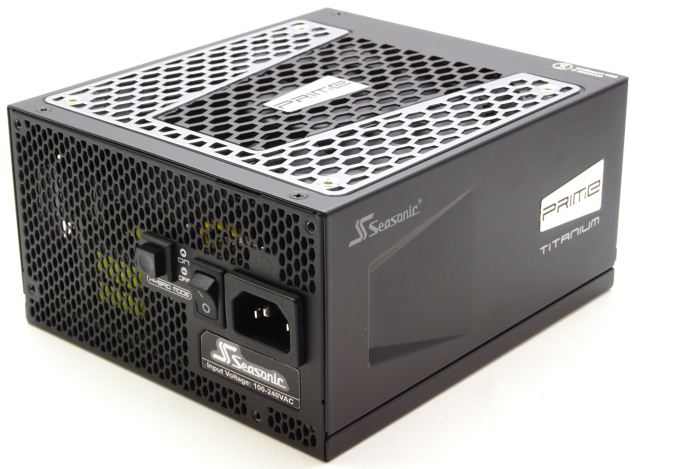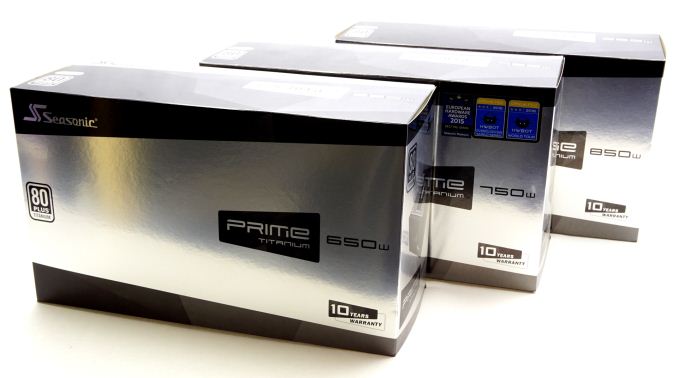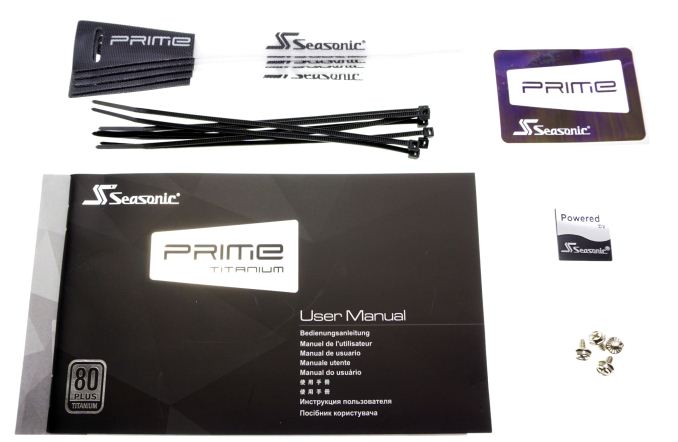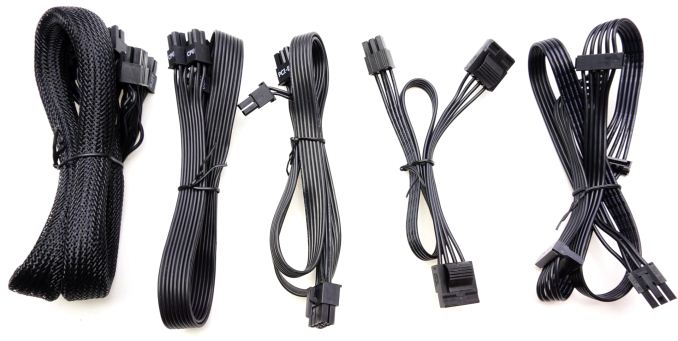The Seasonic PRIME Titanium PSU (650W, 750W, 850W) Review: Mythical Performance
by E. Fylladitakis on April 7, 2017 9:00 AM EST
Founded over 35 years ago, Seasonic is one of the first PC power supply manufacturers and today their products are held in very high regard amongst PC enthusiasts. Despite their high popularity and recognition that the brand name has, the company is one of the very few that did not diversify towards other segments of the market. Seasonic is solely focused on the design, manufacturing and marketing of quality PC power supply units.
During the past several years, we reviewed several of Seasonic’s PSUs, including their latest 80Plus Gold and 80Plus Platinum series. Today we are having a look at their latest product series, the 80Plus Titanium certified PRIME. Seasonic designed the PRIME PSUs to offer the best possible performance and quality they could while keeping the price tag within reasonable limits. The series consists of five units, one fanless 600W model and four regular units with their maximum rated power output ranging from 650W to 1000W. In this review we are going to test three out of the five units of the series, the 650W, 750W and 850W versions. (It is worth noting that the 600W and 1000W versions not yet available to the North American markets, which is sometimes a limitation in our sampling.)
| Model | Price |
| Seasonic PRIME SSR-650TD | $170 incl. shipping |
| Seasonic PRIME SSR-750TD | $175 incl. shipping |
| Seasonic PRIME SSR-850TD | $200 incl. shipping |
| Seasonic PRIME Titanium Power specifications ( Rated @ 50 °C ) |
|||||||
| AC INPUT | 100 - 240 VAC, 50 - 60 Hz | ||||||
| RAIL | +3.3V | +5V | +12V | +5Vsb | -12V | ||
| 650TD | 750TD | 850TD | |||||
| MAX OUTPUT | 20A | 20A | 54A | 62A | 70A | 3A | 0.3A |
| 100W | 648W | 744W | 840W | 15W | 3.6W | ||
| TOTAL | SSR-650TD: 650W SSR-750TD: 750W SSR-850TD: 850W |
||||||
Packaging and Bundle
Seasonic kept their packaging very simple, elegant and functional. The artwork is limited to basic geometric shapes and metallic colors. Our early samples came with an error on the packaging as well - the PRIME units are covered by a 12-year warranty, not 10 years as indicated on our packaging. The packaging is very sturdy, with thick cardboard walls and polyethylene foam pieces protecting the product inside.
Inside the packaging, we found the necessary AC power cable, four typical 3M mounting screws, a good user’s manual, a few typical cable ties, five high-quality cable straps with the company logo, a metallic case badge, and a sticker. There were no thumbscrews or black screws included.
The PRIME PSUs are fully modular. Every cable, including the 24-pin ATX cable, is detachable from the chassis. With the exception of the 24-pin ATX cable that is enfolded in black nylon sleeving, the rest of the cables are “flat”, ribbon-like. All of the cables have black connectors and wires.
| Connector | Seasonic SSR-650TD | Seasonic SSR-750TD | Seasonic SSR-850TD |
| ATX 24 Pin | 1 | 1 | 1 |
| EPS 4+4 Pin | 2 | 2 | 2 |
| EPS 8 Pin | - | - | - |
| PCI-E 6+2 Pin | 4 | 4 | 6 |
| PCI-E 8 Pin | - | - | - |
| SATA | 6 | 10 | 10 |
| Molex | 5 | 5 | 5 |
| Floppy | 1 | 1 | 1 |















86 Comments
View All Comments
GhostOfAnand - Friday, April 7, 2017 - link
High-efficiency is only one perk. The superlative ripple, transient response, etc of these Seasonic units means you're providing your high-end components with quality power. This means longer life, better stability, and greater over-clocking headroom.A solid PSU is the cornerstone of a proper build done right.
Arbie - Friday, April 7, 2017 - link
Written like a true non-engineer.Kevin G - Friday, April 7, 2017 - link
The price difference would pay for itself in 7 years and considering that this unit has a 12 year warranty, the difference certainly would pay for itself. There are also additional factors to consider if say electrical prices increase. Return on investment would occur sooner under such a scenario.The real challenge is if motherboards continue to adhere to the ATX power spec for another decade. Using this power supply down the road could be challenge in that context. To these models credit, it is fully modular so if an ATX replacement were to arrive without adding any additional voltages (i.e. using only 3.3V, 5V and 12V), then an adapter cable could be created.
These are appear to be excellent units worth the price premium they command.
DanNeely - Friday, April 7, 2017 - link
It's not just the whole ATX standard, but all the stuff around it that would make me leery of planning on more than a half dozenish years from a PSU for deciding if the premium is worth it. We've been ATX for the last 20ish years during which time we've gone from 3.3/5V centric to mix low/high voltage centric, to 12V centric designs. Extra CPU power has gone from 6 pin 3.3/5V to a 4pin 12v to 8 pin 12v. Peripheral connectors have gradually gone from Molex to Sata. GPU power has gone from a 4pin Molex to 6pin to 8 pin. While an older PSU may work with suitable adapters (only the CPU connectors and 3.3/5 vs 12v centric designs are breakers); doing so becomes progressively more of a kludge.JasperJanssen - Saturday, April 8, 2017 - link
Yeah, but there's no reason whatsoever to think that we're going to move away from 12V centric any time soon, or ever. It's possible that we're going to drop legacy rails such as 3.3 and 5 like we did -5/-12 (already mostly gone), but I don't see us moving from 12V centric to 24V centric or 48V centric, even if that would give further efficiency advantages, and I don't think the 12-to-1.1V DC-DC converters are meaningfully less efficient than 24 or 48 to 1.1V -- so the possible gains are mostly in using less copper for the current carrying capacity. I don't see that as enough of a gain to overcome the inertia of the whole industry.Plus, the desktop PC industry is dying anyway, and when you're slowly dying is not usually the time to reinvent whole parts unless that can prevent the slowly dying.
Aslan7 - Monday, April 10, 2017 - link
A friend upgraded their qx6600 systen 3-4 years ago, and I got the guts (MB, CPU, RAM) of the old system. Another friend was retiring a Micron Millennia PIII system from ~1997. I was planning to use the qx6600 guts in the Micron Millennia case, but as I was looking at it, I would have needed a massive number of power adapters to be able to plug things in. I said fine, so what?, but then I looked at the 12V output on the PSU. I was short amps. It wasn't even worth buying the adapters to try it. I threw away the guts of the Micron Millennia including the PSU. In short it's going to be a rare 90's power supply that has enough 12V amps that it would be usable today even with adapters.The Micron Millennia case though, is very well designed. The fans clip in and swing out of the way on hinges, there's fans where they're needed. The drive arrangement is nice, the PSU is mounted on a hinge to make cable routing easier. There's plenty of drive bays. All the proper standoffs are there for a large motherboard. It's a really good case especially being from 1997. The only two issues were the power button quit working about 2 years ago, so I have a power button cable run between the side panel and the case, and the other issue was the standoffs for the motherboard are insanely long. I had to special order those so that I had enough to support my large motherboard.
I run a number of personal systems 24/7 doing various tasks for me and while idle performing computations for WorldCommunityGrid.org (curing cancer and such) My main system was powered by a PSU from ~2000. It was rated at 250 and I was pulling somewhere between an estimated 330 and 390 watts 24/7. It felt like it was spitting fire from the exhaust. To the credit of the Chinese no brand power supply it lasted for 16 months running 24/7. To replace that I bought an Enermax Platimax 80+platinum power supply, and about the same time I bought another 80+ platinum power supply for the qx6600. The energy savings have been noticeable with both, and they're cooler and quieter. Sorry, I don't have solid numbers to share,but I'm certain I've saved a large portion of their costs. The frustrating part is seeing reviews for 80+titanium power supplies at less than half the cost of some of the power supplies I bought.
I'm really glad 80+titanium power supplies are happening, but why now? What changed to make these possible? Couldn't these have been made back in 2000? Why weren't they? Or are things honestly that much better manufactured today?
SkipPerk - Wednesday, May 3, 2017 - link
I have often felt the same way, and I think it is just that now that prices have fallen so much, branding matters more. Also, the entire clear PC window case thing has people caring about aesthetics more.That said, modern PSU's are truly better than they have ever been. I am rocking and loving a Seasonic, and it is amazing just how good these new PSU's are. Your Platimax will likely last until the standards change.
HomeworldFound - Friday, April 7, 2017 - link
For a power supply that has a 12 year warranty, that saving is pretty good, it'll last that long. It usually costs me a lot more than that, I get all of my power supply cables individually sleeved.poohbear - Friday, April 7, 2017 - link
Nobody buys these for the savings, they buy it for the rock solid performance when all your components are overlooked to their limits!Gastec - Saturday, August 15, 2020 - link
I compensated by consuming less Kentuky Fried Bourbon for one year.